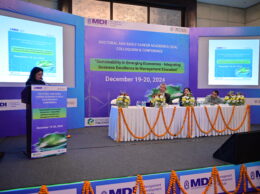By Deepak Sachdeva, Mumbai: A well designed ecommerce website or a web store is attractive and contemporary. But the primary function of the online resources is to sell products or services. Diverting organic traffic to the website on the competitive internet is one challenge. But, converting those visits to sales or subscription orders is a different ball game. Loyalty is as valuable in the online market segment as it is in the offline stores. Motivating customers to make a purchase is the primary goal of personalization.
Online Personalization: Software and technology have advanced enough to tap into real time scenarios on the web. A customer’s tastes, likes, and dislikes are factored in to display dynamic content. The company has to understand the buyer’s search priorities and render relevant web pages. Developers rely on personalization engines to create a satisfactory browsing experience for online visitors. Anyone who has been to Amazon website would notice a colorful array of recommended deals and wish lists. This feature is achieved by successful surveys, clever coding, and big data analytics Knowledge. Research suggests that such pages have the desired positive effect and visits are converted into sales.
Smaller companies with more modest websites implemented this dynamic web feature. They have reported a revenue increase of up to 13% in few months. This is a clear demonstration of the power of digital information. They are able to relate emotionally to the web pages and are displaying a sense of loyalty to brands. Although, the success of this special strategy is beyond doubt, its implementation is not straightforward. Many smaller companies with modest budgets fail to deliver this experience to the customers.
Recent reports suggest that 77% of web stores agree on personalized services. But more than 60% are clueless about technical implementation. In this scenario, Data experts and tech consultants play a crucial role. They have the necessary skills and upgraded knowledge to collect and process data in a strategic manner. The well trained pro is also good at devising clever methods to achieve a predetermined set of goals.
Data Collection
Nothing tangible can really be achieved online without collecting adequate amount of data. All said and done, the internet technologies are computational in nature. Both text and numbers can be crunched at a rapid pace to generate effective results. A customer’s profile and browsing habits are tapped into by clever analysts. Only then the current visitors are served personalized content and messages. Effectiveness is key and accuracy has to be assured for achieving real time success in conversion.
- Page view Tracking
Customers habits and preferences can be gauged using many methods. For busy customers, Surveys are time consuming. But they do browse through the features page of a website. A dynamic notification can be created to match the page headline. This call to action trick is easily achieved through string matching code. The message itself can be timed and pushed if the customer stays longer on this page. Familiarity need not always breed contempt, and the viewer may be pleased by additional information.
This trick is similar to advertising strategy where ad clicks lead the buyer on to relevant landing pages. The notified message is obviously going to lead on the viewer to achieve a conversion. This technique is also very useful in finding the exact match between a service feature and a valuable product. These dynamic notifications and messages can be made more appealing through visual and auditory aids. However, the website’s product and services have to be relevant for making these value additions.
- Customer Surveys
Surveys are valuable if there are a large number of visitors who turn into respondents. The questionnaires have to be innovative and strategic. Significant amount of statistical data is processed to extract relevant information. The negative side is that the surveyed customer may deliver insufficient or erroneous responses. Mathematical techniques do factor in error coefficient and approximations. But accurate estimates depend on proportion of responses and utility value of the answers. Technical tools include forms, CRM, marketing automation, database queries, and integrated mobile apps.
- Overlays
A full screen overlay may be irritating and discourage some viewers. But the full page display with short message is a colorful addition. The call to action normally includes a form with name, phone, or email address fields. The ingenuity lies in matching the customer’s interest with a meaningful overlay message. The pages being visited give a good idea, and the message can be customized appropriately. A customer searching a kitchen appliance such as an oven would naturally be delighted with cake recipes. These overlays have achieved a respectable conversion rate of 4% for some web sites.
- Location Data
There is a lot of data on the internet, and branding companies select key account holders with big corporations. They use these demographic cues to understand consumer behavior. The location of a customer is a valuable trigger for catalogue pages. A viewer from cold climate would be delighted by a hot cup of coffee, sweaters, and gloves. Home pages are also altered using the database results to increase conversion rates. Some sites have reported an overwhelming increase in subscriptions based on personalized home pages.
- Smart Lists
Web developers, Advertisers prepare smart lists that work silently in the background. The creation of these lists is a little complex, but they assist in personalization. They get constantly updated behind the scenes to add or remove visitors. Page visits, add clicks, book downloads, and free software trials can be used to add or delete list entries. The data collected through this method is a reliable source for devising customized pages or props.
- Other Tools
There are many other cool tools and tips that are implemented by smart developers. They send email messages with link clicks and collect response data. They collect visitors’ data using browser cookies and devise automated ad campaigns. These ads are saved for the next visit and the customer’s response is tracked. A large number of marketing automation tools are used independently or together. Market segments are targeted through funneling methods and referral sources. A few superior quality technologies include CMS and COS for content management and optimization.
Conclusion
The online customers have to be converted into buyers or subscribers through personalization. A variety of sources are used to collect the relevant data from them. This data is processed and the resultant information is valuable. It is used to design and deploy dynamic content that reflects the buyer’s tastes and preferences. The personalization tricks depend on web developer’s strategies and data-related tricks. These include survey results, overlay calls-to-action, background lists, and page view tracking. Cookies are also used to collect data from the browser, and the sophisticated tools are CMS and COS.
Author Bio: Deepak Sachdeva is an Internet Marketer and digital consultant. Loves exploring new online marketing techniques and helping businesses build online brands. He likes writing on topics like Digital Marketing and Education. In education, his favourite space is Big Data Analytics, Artificial Intelligence and Cloud Computing.









